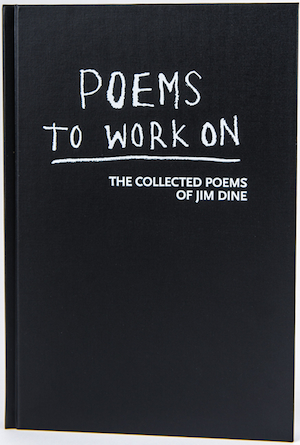

home | books | poetry | plays | translations | online | criticism | video | collaboration | press | calendar | bio
| Art Books and Catalogues | Curatorial | Poetry | Translation |
 Poems to Work On: The Collected Poems of Jim Dine
Edited, with a foreword, by Vincent Katz Hardcover, 290 pages Now available at Cuneiformpress.com Poems to Work On review in Jack Kimball's Pantaloons blog I swore I would never write another blurb, but Jim Dine’s Collected Poems has pulled me temporarily out of blurb retirement. The same verve that drives his paintings drives these poems, and added to it are a wonderfully goofy playfulness and a no-holds-barred, slightly scary exhilaration. Arp, Schwitters, and Picabia, move over. —Ron Padgett In the flutter of blue alcohol flame a figure enters its shadow asking where do you keep all the things / that don’t fit in your mind? Characters appear, vanish, reappear in the darkness but there is no space behind language. A mountain opens and red is registered. I’ve carried Jim Dine’s first book Welcome Home, Lovebirds through many moves since 1969. Now almost half a century later I have the delight of being again in that mind. The poems are as direct as brush-strokes, as casual as conversation, as passionate as loss. The background shifts. “The Short History of New York” beautifully nails that. London in the 1960s is palpable; Paris, Rome, flicker. Friends share the space. “Portrait” is a concisely brilliant one of Robert Creeley. Kenneth Koch, a hometown boy, makes occasional appearances. But all these are tones, not the foreground that is the restlessness, the questioning, the observation inhabited by the reader. For me a particular pleasure of these poems has been the privilege of at times perceiving the world as a painter — Jim Dine made my eyes feel. Poems To Work On is not only “NIGHT’S / FRIABLE / RAGE, but making life / without reason /is the reason/ for a /common dream.” Writing well worth reading. —Tom Raworth ABOUT THE AUTHOR Jim Dine emerged onto the New York art scene via The Happenings in the early 1960s, when he was in his mid 20s. Some of the pieces he performed then used language, others struggled in muteness at the impossibility of words, and they were provoked by personal experiences. At Cornell in the mid-1960s, Dine met Robert Creeley, which galvanized his interest in poetry. Entering a vibrant scene of poets, painters, and musi- cians in London in the late 1960s, Dine embarked on his first prolific period of poetry writing, which culminated in the publication of Welcome Home Lovebirds by Trigram Press in 1969. The book’s subtitle is “poems and draw- ings,” and this combination makes explicit the crossover quality that defines Dine’s outlook towards the arts and life. Dine has explored an expansive approach, working in painting, drawing, printmaking, sculpture, photogra- phy, and performance, in addition to writing. Yet, this period was followed by an abrupt change. Though he wrote and published poems in his early 30s, he stopped writing poetry in the 1970s, after moving back to the States, where he holed up in Putney, Vermont, to refine his drawing technique. It wasn’t until two decades later that he returned to the writing of poetry, this time coupled with a new involvement with various photographic techniques. Since the mid-1990s, Dine has enjoyed a resurgence of poetry writing, which continues apace and shows no sign of abatement. Dine was a poet, though, even in those times when he was not writing or publishing things that look like what we ordinarily call poems. Much of his oeuvre as a visual artist can justifiably be described as poetry, if we use as a definition of poetry: taking one thing and making it into something else. When he hung a screwdriver on a canvas, or when he made a detailed drawing of a pair of pliers, when he collaborated on an artist’s book with an- other poet, the activity could easily be called poetic. Dine thinks in poetry, a useful definition of a poet... —From the Foreword by Vincent Katz |
|||
| BACK | |||
| index | |||